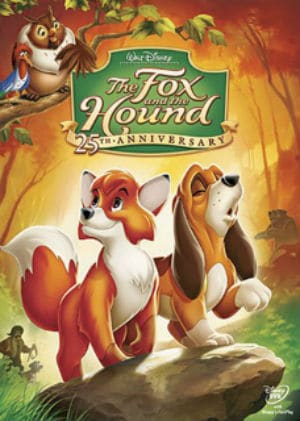Revisiting Disney – The Fox and the Hound
Welcome to Revisiting Disney! Today, we’re looking at that movie which, let’s all be honest, made us cry, The Fox and the Hound! Like last time, I have labeled each category so if you want to skip to the parts that interest you most, feel free. And, of course, if you have any thoughts, burning or otherwise, please share in the comments!
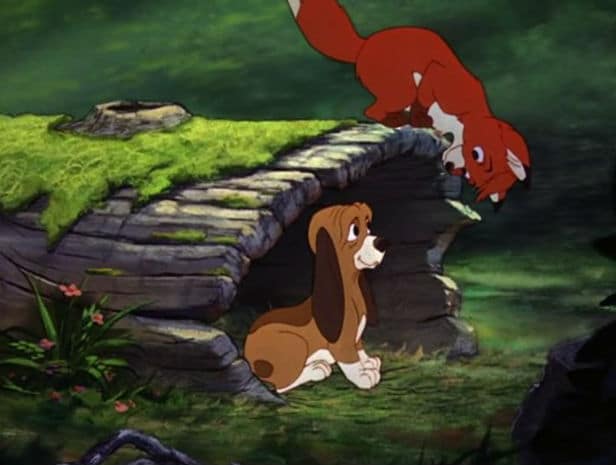
BACKGROUND
Released on July 10th, 1981, The Fox and the Hound was originally supposed to be released on Christmas Day of 1980. The film’s release date got pushed back to July when a group of animators led by Don Bluth left the studio.
Don Bluth had worked for the Disney Studio off and on, working as an in-betweener on Sleeping Beauty, as well as working for the Studio over the summers. In 1971, he began working for the Disney Company as an Animator (working on Robin Hood) and later served as an animation director for both The Rescuers and Pete’s Dragon. He also worked as Producer and Director on the short film The Small One.
With fellow animators Gary Goldman and John Pomeroy, Bluth developed an independent film, Banjo the Woodpile Cat. In September of 1979, the three animators resigned from Disney to form their own studio. Of course, the story is a bit more complicated than it sounds. The Disney Studio was coming under a bit of fire because many thought that the animation quality in the Disney Studio had drastically decreased since Disney’s death.
This fact, combined with a rumor that the Studio might close down lead to a walkout. The animators who left with Bluth, Goldman and Pomeroy joined the new studio and created such films as An American Tale, The Secret of NIMH, and The Land Before Time.
The Fox and the Hound was the last of the Disney films to have the credits shown before the film. Starting with The Black Cauldron, Disney films would have closing credits. Produced by Wolfgang Reitherman and Art Stevens, this was the directorial debut for Richard Rich (who would go on to direct The Black Cauldron and 1994’s The Swan Princess). Other directors included Art Stevens and Ted Berman.
MUSIC
The score for The Fox and the Hound was composed by Buddy Baker, who had also composed the score for The Many Adventures of Winnie the Pooh. Baker was born in 1918 in Missouri. He started his career in the late 1930’s by playing trumpet in big bands. Baker wrote the music for numerous Disney shorts, the Haunted Mansion, and worked on the music for Epcot. Honored as a Disney Legend in 1998, he passed away in California in 2002.
Big Mama, the owl, is voiced by Pearl Bailey. Bailey was a composer, singer, songwriter, and dancer. She sang three of the five songs, “Best of Friends,” “Lack of Education,” and “Appreciate the Lady,” while Jeanette Nolan sang “Goodbye May Seem Forever,” and Jack Albertson sang “A Huntin’ Man.”
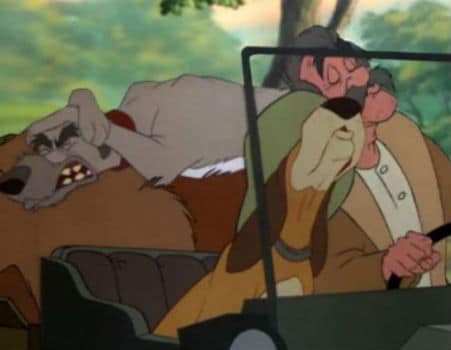
“Best of Friends” was written by Richard Johnston and Stan Fidel, “Goodbye May Seem Forever” by Richard Rich and Jeffrey Patch, with Jim Stafford writing the music and lyrics for the other three. Jim Stafford is an actor and composer who was born in 1944 in Florida. He is still living today.
The music is interesting and reminds me of Bambi in that it’s a very much part of the story. Even before the characters talk, the music and the animation work together to tell us exactly what we should be feeling. While the score feels a little less subtle at times than other Disney films (to this point), that’s not necessarily a bad thing. It’s just different (and it’s the early 80’s. James Horner will be manipulating our emotions through music in animated films soon enough).
ANIMATION
While this was one of the first films for animators Glen Keane, Mark Henn, Mike Gabriel, and Mark Dindal, this was also the last film for veteran animators Frank Thomas and Ollie Johnston. These two animators (along with Marc Davis) have been my artistic heroes ever since I watched a behind-the-scenes feature on Sleeping Beauty and heard them talking about their character design. So, this section might get a little long.
Frank Thomas and Ollie Johnston worked together very well, and on at least one Disney DVD there was a documentary about their friendship and how it influenced their art. They were, according to the other animators, always bouncing things off of each other and were very close friends who had met at Stanford while art students there. Frank Thomas was hired at Disney first and arranged Ollie’s audition for Disney.
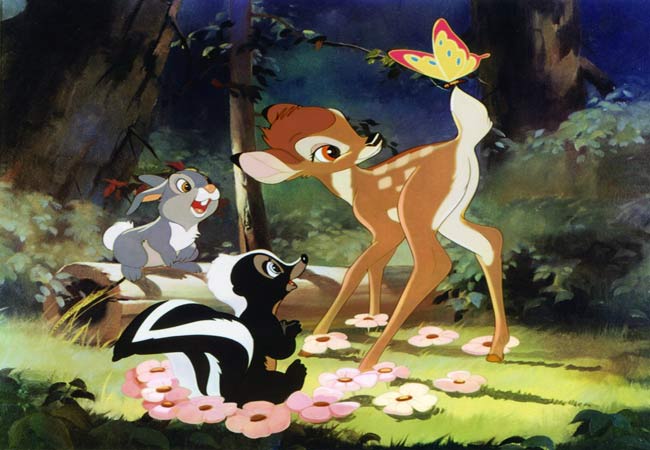
This was the last film that Thomas and Johnston worked on before passing the torch to the new generation of animators, and since I’ve been talking about their achievements since Pinocchio, I won’t go too in-depth telling you all the films they worked on. However, as two of the last Nine Old Men, here is a bit about them and their lives.
Frank Thomas was born in Santa Monica, CA on September 5th, 1912. He began working for Disney in 1934 and retired in 1978, although he did story work on The Fox and the Hound. He took a break from Disney when he served in the US Air Force from 1942 to 1946 and was often responsible for animating the villain.
Thomas animated such characters as Cinderella’s Lady Tremaine, and Captain Hook in Peter Pan. Although he suffered a stroke in 1996, he was still present and involved in many behind the scenes features that were made for Disney in the ’90’s. He passed away in California on September 8th, 2004 at age 92 after a cerebral hemorrhage. His wife, Jeanette, would pass away in 2012 in Pasadena.
Ollie Johnston was born Oliver Martin Johnston on October 31, 1912, in Palo Alto California. He began working for Disney in 1935 and retired, like Frank Thomas, in 1978 (although, again, both did story work for The Fox and the Hound). In 2005, Johnston won the National Medal of Arts and after his retirement, he began speaking at schools and film festivals. He also wrote some of the (in my opinion) best books on animation, particularly full of insight regarding the classic Disney films.
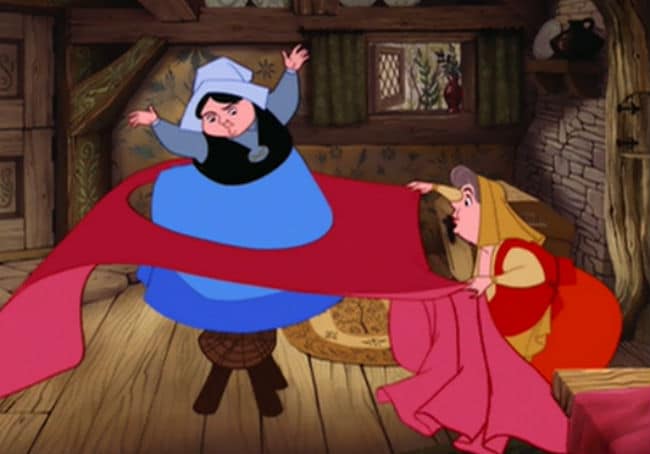
According to his IMDB page, he was most proud of his work on Bambi, because of the strong emotional response it got from the audience, proving that animated films could be just as powerful as live-action ones. He often animated female characters or young children.
Johnston died on April 14th, 2008 in Sequim, Washington of natural causes at the age of 97. His wife, Marie, passed away in 2005. I found it very interesting that she also worked for Disney in the Ink and Paint Department. He was, before his death, the last of the Nine Old Men.
The Fox and the Hound was John Lasseter’s first job at the Disney Studio. Lasseter is known today as the Chief Creative Officer of Pixar Animation Studios, Walt Disney Animation Studios, and DisneyToon Studios, as well as serving as the Principal Creative Advisor for Walt Disney Imagineering. In The Fox and the Hound, he worked on Copper, and also assisted Glen Keane with the fight scene against the bear.
Tim Burton was also involved in The Fox and the Hound. He did the animation for Vixey, the female fox. Supposedly, he didn’t like her at first (she was too different from the usual characters he drew) and he only animated the close-ups when he had grown to like her as a character.
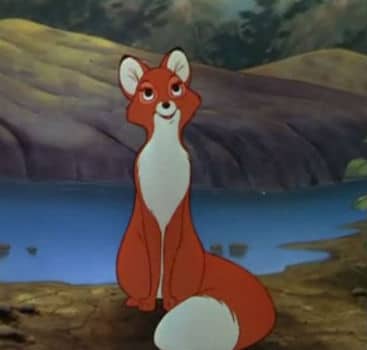
The supervising animators included Thomas and Johnston, but also added in Glen Keane, Randy Cartwright, Cliff Nordberg, and Ron Clements. As I said in the music section, this film feels a lot like Bambi in some ways, and I think that really has to do with the way the film is focused on the natural world and the way the background and music complement the characters, looking realistic without being overwhelming.
THE PLOT
The film opens with a mother fox running through the forest and across fields, carrying her kit and followed by the sound of a hound. As she races, an owl sees her and watches. The mother fox hides her baby and runs as fast as she can. I assume she’s hoping to draw away the dogs.
As she runs over the hill, however, a shot rings out. As Big Mama the owl makes a horrified face, I realize that probably mirrors the face I made when I realize that Disney has killed off a character within five minutes of starting the film. I suppose Tod has to be orphaned for the plot to progress, but still.

Mama Owl finds him and, realizing that she can’t take care of him, realizes that she knows who can. She, along with fellow birds Dinky and Boomer, cause a ruckus and draw the Widow Tweed to where Tod is hiding. Widow Tweed decides she can’t leave Tod alone, so she decides to adopt him.
At the same time, her neighbor Amos Slade brings home a little hound puppy named Copper and tells his old dog Chief to look out for the little guy. When Tod gets into mischief on Widow Tweed’s farm, she sends him out to play. Tod seeks out the birds, Dinky and Boomer, but they are busy trying to find and eat a “fuzzy worm.” This chasing of the worm, I’m guessing, will be a theme throughout the movie for these two.
Tod, when he realizes his friends are too busy to play, decides to chase a butterfly. As luck would have it, Copper smells Tod and goes to investigate. Since they’re both looking for a friend and they don’t know that they’re supposed to be enemies, they play hide and seek and decide to be best friends.
There are problems, of course. People don’t like it when their hound dogs wander off, and Copper’s owner is no exception. When Copper wanders off one too many times and is chained up, Tod goes to see his friend. When Tod wakes Chief up, Chief recognizes a fox as his enemy and gives chase.
Tod escapes and makes it back to Widow Tweed just in time, but since he and Chief has a chase that also went into the henhouse, Amos Slade thought he was after his chickens and promises to shoot him if he saw him again. Amos takes Copper and Chief on a hunting trip, and when Copper returns both he and Tod have grown up.
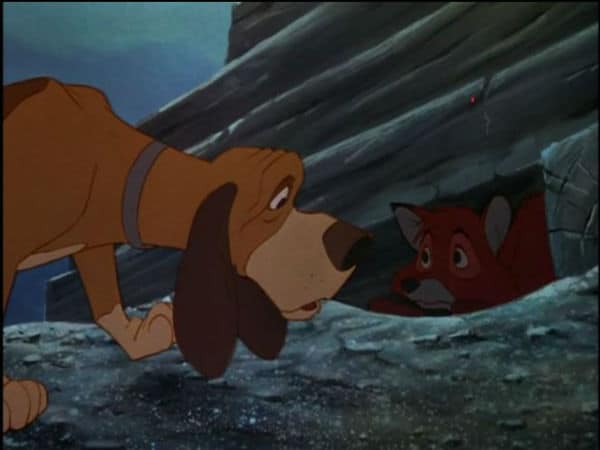
During the hunting trip, Copper proves his skills and is honored with the shotgun position on the trip back home. While Copper is learning how to be a hound dog, Tod is also growing up. When he goes to see his friend, Copper tells him things are different. Chief and Slade see Tod and give chase. Copper finds him, but instead of turning him in tells him that they can’t be friends anymore, but he’ll let him go this one time.
After Tod accidentally causes Chief to be seriously injured, Copper and Slade vow revenge. To protect Tod, Widow Tweed leaves him in a game preserve where Slade can’t hurt him. It’s one of those scenes that, if you weren’t already crying during the movie, would make you cry.

After a stormy night where Tod is trying to figure out how to live in his new home, Big Mama introduces him to a beautiful lady fox named Vixey. Although they both like each other, when Tod tries to show off, it ends badly. Vixey laughs at Tod’s silliness, and he calls her an “empty-headed female.” Luckily, Big Mama helps the two patch things up.
Tod begins to grow more comfortable in his new environment. Meanwhile, in an attempt to catch Tod, Slade and Copper enter the game preserve and set out a string of steel traps on a path that Tod likely uses often. They hide behind a boulder and wait.
Luckily for Tod, Vixey is there and can tell that something is up, so he proceeds with caution, escaping from all the traps (though there was a fair amount of luck involved as well). Sending Vixey ahead to the safety of their burrow, Tod prepares for a fight to the death with his former friend.
Escaping and running to the burrow, Tod finds Vixey. With Copper trying to get in the front door, they try to escape out the back. Unfortunately, they find Slade there with his gun. In another move that reminds me a lot of Bambi, Slade starts a fire and places it on the back entrance, trying to force the foxes into the path of his gun and his hound. It doesn’t work this way, and the two escape by running through the burning entrance. Luckily, they aren’t hurt and a forest fire is not started.
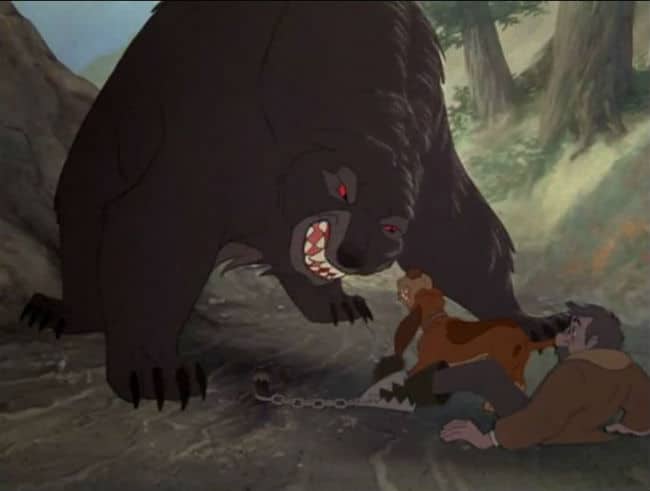
As Copper tracks Tod and Vixey, he and Slade find themselves facing an even bigger problem, a large angry bear. While attempting to defend himself, Slade is caught in a trap, maybe even one of his own. With nowhere to run, he is defenseless. Copper steps in to defend his master, but is unable to defeat the beast.
Tod, as he is running away, hears Copper’s yelp of pain during the battle and rushes back to save his former friend. The bear chases Tod across a log bridge, which then collapses under his weight. Tod risked his life to save Copper, so, when Slade is about to kill Tod, at last, Copper intervenes and saves his friend.
The ending is bittersweet. Copper and Tod can’t be best friends anymore; not only do they have a difficult past, but they are natural enemies. In the end, they both go off and live their lives.
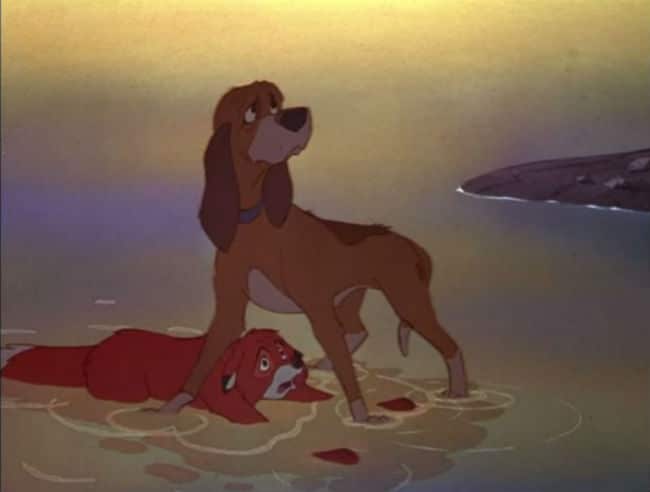
Copper continues to be a hunting dog (though I assume he no longer hunts foxes), Tod and Vixey settle down, the “fuzzy worm” that Dinky and Boomer have been chasing ends up becoming a beautiful butterfly, and Slade and the Widow Tweed become friends of a sort. The story ends with Copper and Tod remembering their childhood friendship. If you still haven’t been crying during this movie, you probably are by the time it ends.
SOURCE MATERIAL
First of all, a fun and little-known fact – The Fox and the Hound was based on a book by Daniel P. Mannix. The book won the Dutton Animal Book Award in 1967, the Athenaeum Literary Award, and was a Reader’s Digest Book Club selection. Published in 1971, the story follows a fox named Tod and the hound named Copper through their lives, but that is where the similarities end.
The two were not childhood friends; rather, Tod was the animal that Copper had devoted his life to killing. The biggest changes, however, can be seen in casualties that occur in the book but not in the film. Tod causes the death of another dog, but it’s a pup, not an old dog, and it is deliberate. Copper later kills Tod’s mate and cubs out of revenge.
As I was reading about it, I became intrigued and it has been added to my list (but only after I read Old Yeller. Like I said, I heard it was sad). I don’t want to spoil the ending without warning, but from what I read, it was tragic. The book is available on Amazon in Kindle and regular book form.

SPOILER FOR BOOK
Okay. So, you all know how at the end of the Disney movie, it’s bittersweet because Cooper and Tod can’t be friends, but they have a truce to not kill each other, and even the widow and the hunter become friends of a sort? Well, in the book, after all, the murder and chasing, Tod just dies of exhaustion while being chased by Copper.
To make things worse, the hunter has to go to a nursing home. Since dogs aren’t allowed, instead of finding his beloved hound an alternative home, he kills Copper. Basically, the only character to make it to the end of the story is an old man who feels he has no other choice than to shoot his oldest and dearest friend, his dog.
The ending of the Disney movie may sting a bit, but the ending of the book is a sob-fest. I got teary just reading about it. So, that’s the book version of The Fox and the Hound (because kids don’t need happy endings, apparently).
BOOK SPOILER OVER
The 1980’s
We have officially left the ’70’s behind, and entered the 1980’s. The History Channel tells me that, as a response to the uncertainty and fear of the ’70’s (including the Watergate Scandal), many Americans began to seek a more conservative outlook in politics, economics, and social life.
They also tell me that the ’80’s are often remembered for materialism, consumerism, MTV, and big hair (I added that one). In the 1980’s, America was still involved in the Cold War and in 1982, almost a million people rallied in Central Park to support a nuclear freeze. This has been called one of the largest demonstrations in United States history.
The New Right (a populist conservative movement) was growing. In 1980, Republican Ronald Reagan won the Presidential election over the current President, Democrat Jimmy Carter.
Popular culture in the ’80’s was wonderful, giving rise to such classics as E.T. The Extra-Terrestrial, Return of the Jedi, Raiders of the Lost Ark, The Breakfast Club, Pretty in Pink and Some Kind of Wonderful. We also got more home programming for the consumer and MTV.
LESSONS LEARNED
I suppose the main lesson learned here is that love is a powerful thing. Not just romantic love, but also love between friends, love between parents and children (even furry ones), and the love between siblings. The love of Slade for his dogs is a redeeming quality in his character. Widow Tweed loves Tod, which leads her to protect her and to let him go for his own safety. Tod risks everything to protect Vixey, Copper steps between Tod and a gun, Tod fights a bear to save Copper, and Copper fights a bear to save Slade. Also, it was Copper’s love for Chief that lead him to fight with Tod in the first place.
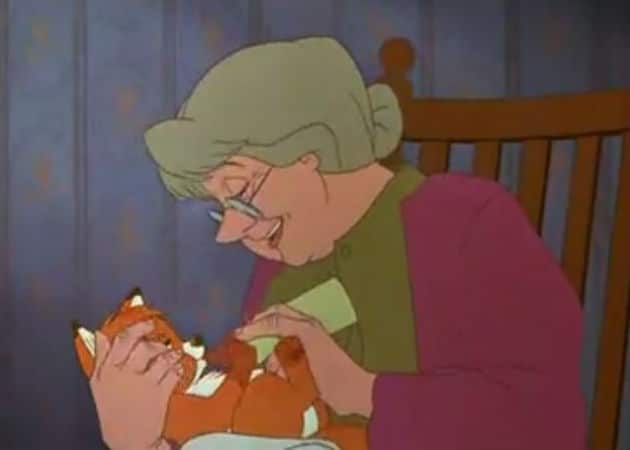
The other lesson, I suppose, is that revenge doesn’t help anyone. Slade’s vengeance against Tod almost costs him his life, and it was only the love of Copper (and Tod) that saved him.
DOES IT HOLD UP?
Personally, The Fox and the Hound was never my favorite Disney movie as a kid, and this rewatch reminded me of why. It’s a beautiful movie, but I cry. The fact that it starts out sad and ends bittersweet made it one that I liked to watch every once in a while, but it’s just so sad! While as an adult I can appreciate it as a work of art and as a movie that is pretty beloved still today, it’s still not my favorite. I cry enough at Pixar movies, thank you very much.
Fun Fact: Adult Tod is voiced by Mickey Rooney, who also voiced Santa Claus in most of the Christmas specials produced by Rankin/Bass.
For next week: The Black Cauldron
If you enjoyed this post and the others in the Revisiting Disney series, and have found yourself wishing that you could find them all in one convenient and bound book with eight extra essays, there is an option for you! Check out A Journey Through Disney: My Look Back Through Disney Canon, now available on Amazon as both a Kindle book ($4.99) and a paperback ($11.99).
OTHER SOURCES:
https://thewaltdisneycompany.com/about-disney/disney-history
http://www.history.com/topics
http://studioservices.go.com/disneystudios/history.html
Bailey, Adrian. Walt Disney’s World of Fantasy. Everest House Publishers. New York, New York. 1982.
Finch, Christopher. The Art of Walt Disney: From Mickey Mouse to the Magic Kingdom. Harry N. Abrams, Inc. New York, New York. 1975.
Sale, Roger. Fairy Tales and After: From Snow White to E.B. White. Harvard University Press. Cambridge, MA, 1978.
Tatar, Maria. The Annotated Classic Fairy Tales. W.W. Norton and Company. New York and London, 2002.
Thomas, Frank. Disney’s Art of Animation From Mickey Mouse to Hercules. Hyperion. New York, New York. 1992.
ARE YOU A ROMANCE FAN? FOLLOW THE SILVER PETTICOAT REVIEW:
 Our romance-themed entertainment site is on a mission to help you find the best period dramas, romance movies, TV shows, and books. Other topics include Jane Austen, Classic Hollywood, TV Couples, Fairy Tales, Romantic Living, Romanticism, and more. We’re damsels not in distress fighting for the all-new optimistic Romantic Revolution. Join us and subscribe. For more information, see our About, Old-Fashioned Romance 101, Modern Romanticism 101, and Romantic Living 101.
Our romance-themed entertainment site is on a mission to help you find the best period dramas, romance movies, TV shows, and books. Other topics include Jane Austen, Classic Hollywood, TV Couples, Fairy Tales, Romantic Living, Romanticism, and more. We’re damsels not in distress fighting for the all-new optimistic Romantic Revolution. Join us and subscribe. For more information, see our About, Old-Fashioned Romance 101, Modern Romanticism 101, and Romantic Living 101.

